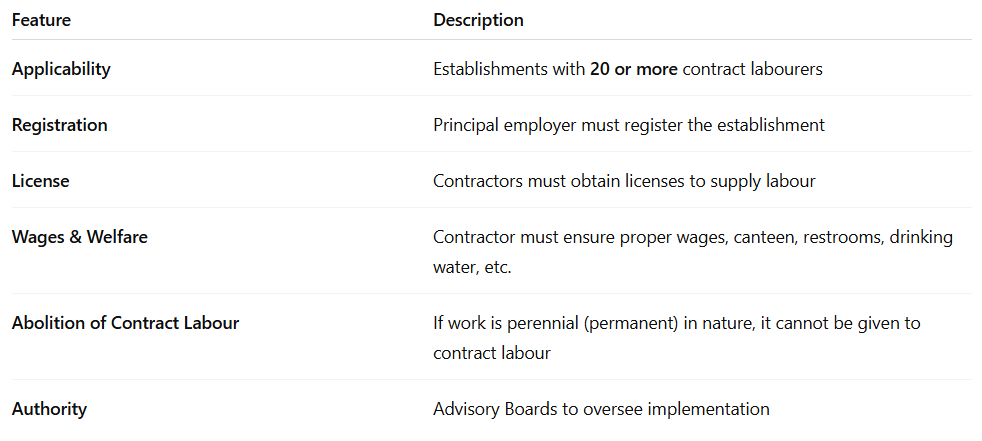Unit 4: The Payment of Minimum wages act 1948
The Payment of Minimum Wages Act, 1948
Objective: To ensure that workers are paid minimum wages to maintain a basic standard of living.
Key Provisions
Revisions and Updates
Code on Wages, 2019
- Merged Acts: Combines 4 wage-related laws, including this Act.
- Universal Coverage: Applies to all employees (organized/unorganized sectors).
- National Floor Wage: Central Government to fix a floor wage.
- Gender Equality: Equal pay for equal work for men and women.
2020 Update
- Rules Drafted: Draft rules for Code on Wages notified.
- Digital Wages: Encouraged digital transactions for wage payment.
2021 Update
- Implementation Pending: Though Code on Wages was passed in 2019, it’s yet to be fully enforced (as of early 2024).
- States’ Readiness: States were in the process of notifying their rules.
The Contract Labour (Regulation and Abolition) Act, 1970
Objective: To regulate the employment of contract labour and provide better working conditions.
Recent Trends & Issues
- Contract Labour Regularization: Increasing demand to make contract workers permanent due to long-term employment.
- Digitization & Compliance: Push for using digital platforms for wage records and labour management.
These acts aim to protect vulnerable workers from exploitation, ensure fair wages, and regulate contract-based employment. The reforms under Code on Wages show a move towards simplification and universal protection in India's labour laws.
The Employees’ State Insurance (ESI) Act, 1948
Objective: To provide social security benefits to workers in case of sickness, maternity, injury, and employment-related disability or death.
Key Features
Latest Amendments
2019 Amendment (via Code on Social Security, 2020)
The Code on Social Security, 2020 consolidates ESI Act with other social
security laws.
- Coverage expansion: Provision for voluntary registration by establishments with fewer than 10 employees.
- Gig & Platform Workers: Brought under the ambit for future coverage.
- Digitization: Online registration and compliance filing via Shram Suvidha portal.
Child Labour (Prohibition & Regulation) Act, 1986
Objective: To prohibit the engagement of children in certain
employments and regulate the conditions of work for children in other
occupations.
Original Provisions
Latest Amendments
Child Labour (Prohibition and Regulation) Amendment Act, 2016
- Total Prohibition: Complete ban on employment of children below 14 years in any occupation or process.
- Exception: Children allowed to help in family enterprises after school hours or during vacations.
- Adolescents Defined: Persons between 14–18 years.
- Hazardous Work Ban: Adolescents prohibited from hazardous occupations (now reduced to 3 major sectors).
Stricter Penalties
- Employer: Imprisonment (6 months to 2 years), Fine (₹20,000 – ₹50,000)
- Parents: No penalty for first offence
Latest Developments (2020–2023)
- National Child Labour Project (NCLP) Scheme continues to identify and rehabilitate child labour.
- More focus on education, vocational training, and digitization of rescue/rehab processes.
- Platform Integration: Complaints through PENCIL Portal (https://pencil.gov.in) for tracking and reporting child labour.
The Trade Unions Act, 1926
Objective: To provide legal status and protection to trade unions
and to regulate their formation, registration, rights, and liabilities.
Key Provisions
Child Labour (Prohibition and Regulation) Act, 1986
Objective: To prohibit the employment of children below a certain
age and regulate the conditions of work for children and adolescents.










